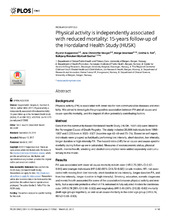| dc.description.abstract | Background: Physical activity (PA) is associated with lower risk for non-communicable diseases and mortality. We aimed to investigate the prospective association between PA and all-cause and cause-specific mortality, and the impact of other potentially contributing factors. Method: Data from the community-based Hordaland Health Study (HUSK, 1997–99) were linked to the Norwegian Cause of Death Registry. The study included 20,506 individuals born 1950–1957 and 2,225 born in 1925–1927 (baseline age 40–49 and 70–74). Based on self-report, individuals were grouped as habitually performing low intensity, short duration, low intensity, longer duration or high intensity PA. The hazard ratios (HR) for all-cause and cause-specific mortality during follow-up were calculated. Measures of socioeconomic status, physical health, mental health, smoking and alcohol consumption were added separately and cumulatively to the model. Results: PA was associated with lower all-cause mortality in both older (HR 0.75 (95% CI 0.67–0.84)) and younger individuals (HR 0.82 (95% CI 0.72–0.92)) (crude models, HR: risk associated with moving from low intensity, short duration to low intensity, longer duration PA, and from low intensity, longer duration to high intensity). Smoking, education, somatic diagnoses and mental health accounted for some of the association between physical activity and mortality, but a separate protective effect of PA remained in fully adjusted models for cardiovascular (HR 0.78 (95% CI 0.66–0.92)) and respiratory (HR 0.45 (95% CI 0.32–0.63) mortality (both age-groups together), as well as all-cause mortality in the older age group (HR 0.74, 95%CI 0.66–0.83). Conclusion: Low intensity, longer duration and high intensity physical activity was associated with reduced all-cause, respiratory and cardiovascular mortality, indicating that physical activity is beneficial also among older individuals, and that a moderate increase in PA can be beneficial. | en_US |

